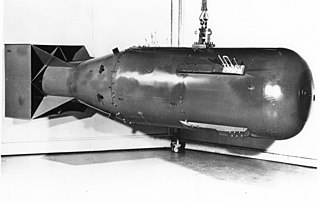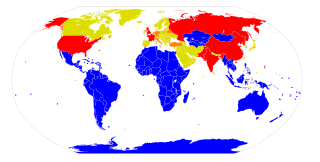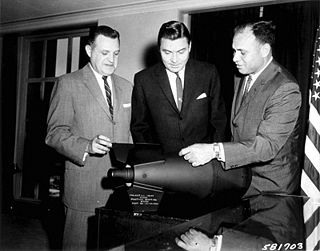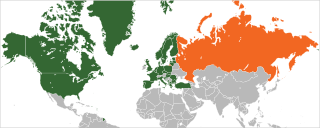
Nuclear warfare, also known as atomic warfare, is a theoretical military conflict or prepared political strategy that deploys nuclear weaponry. Nuclear weapons are weapons of mass destruction; in contrast to conventional warfare, nuclear warfare can produce destruction in a much shorter time and can have a long-lasting radiological result. A major nuclear exchange would likely have long-term effects, primarily from the fallout released, and could also lead to secondary effects, such as "nuclear winter", nuclear famine and societal collapse. A global thermonuclear war with Cold War-era stockpiles, or even with the current smaller stockpiles, may lead to various scenarios including the extinction of the human race.

Iceland's defence forces consist of the Icelandic Coast Guard, which patrols Icelandic waters and monitors its airspace, and other services such as the National Commissioner's National Security and Special Forces Units. Iceland maintains no standing army, the only NATO member for which this is the case.

World War III or the Third World War, often abbreviated as WWIII or WW3, are names given to a hypothetical worldwide large-scale military conflict subsequent to World War I and World War II. The term has been in use since at least as early as 1941. Some apply it loosely to limited or more minor conflicts such as the Cold War or the war on terror. In contrast, others assume that such a conflict would surpass prior world wars in both scope and destructive impact.

USS Monterey (CG-61) is a Ticonderoga-class guided-missile cruiser that served in the United States Navy. She is the fourth US Navy vessel named for the Battle of Monterrey at Monterrey, Nuevo León during the Mexican–American War in 1846. She was built at Bath Iron Works in Maine. The ship was decommissioned on 16 September 2022.

Power projection, in international relations, is the capacity of a state to deploy and sustain forces outside its territory. The ability of a state to project its power into an area may serve as an effective diplomatic lever, influencing the decision-making process and acting as a potential deterrent on other states' behavior.

The German Air Force is the aerial warfare branch of the Bundeswehr, the armed forces of Germany. The German Air Force was founded in 1956 during the era of the Cold War as the aerial warfare branch of the armed forces of then West Germany. After the reunification of West and East Germany in 1990, it integrated parts of the air force of the former German Democratic Republic, which itself had been founded in 1956 as part of the National People's Army. There is no organizational continuity between the current German Air Force and the former Luftwaffe of the Wehrmacht founded in 1935, which was completely disbanded in 1945/46 after World War II. The term Luftwaffe that is used for both the historic and the current German air force is the German-language generic designation of any air force.

The B61 nuclear bomb is the primary thermonuclear gravity bomb in the United States Enduring Stockpile following the end of the Cold War. It is a low to intermediate-yield strategic and tactical nuclear weapon featuring a two-stage radiation implosion design.

Number 12 Squadron, also known as No. 12 (Bomber) Squadron and occasionally as No. XII Squadron, is a flying squadron of the Royal Air Force (RAF). The squadron reformed in July 2018 as a joint RAF/Qatar Emiri Air Force squadron. It is currently based at RAF Coningsby, Lincolnshire, and operates the Eurofighter Typhoon FGR4, while temporarily integrating Qatari air and ground crews in order to provide training and support as part of the Qatari purchase of 24 Typhoons from the UK.

Although the Netherlands does not have weapons of mass destruction made by itself, the country participates in NATO's nuclear weapons sharing arrangements and trains for delivering US nuclear weapons. These weapons were first stored in the Netherlands in 1960.

Nuclear sharing is a concept in NATO's policy of nuclear deterrence, which allows member countries without nuclear weapons of their own to participate in the planning for the use of nuclear weapons by NATO. In particular, it provides for the armed forces of those countries to be involved in delivering nuclear weapons in the event of their use.
Able Archer 83 was the annual NATO Able Archer exercise conducted in November 1983. The purpose for the command post exercise, like previous years, was to simulate a period of conflict escalation, culminating in the US military attaining a simulated DEFCON 1 coordinated nuclear attack. The five-day exercise, which involved NATO commands throughout Western Europe, was coordinated from the Supreme Headquarters Allied Powers Europe (SHAPE) headquarters in Casteau, Belgium.

Although Germany has the technical capability to produce weapons of mass destruction (WMD), since World War II it has generally refrained from producing those weapons. However, Germany participates in the NATO nuclear weapons sharing arrangements and trains for delivering United States nuclear weapons. Officially, 20 US-nuclear weapons are stationed in Büchel, Germany. It could be more or fewer, but the exact number of the weapons is a state secret.

A tactical nuclear weapon (TNW) or non-strategic nuclear weapon (NSNW) is a nuclear weapon that is designed to be used on a battlefield in military situations, mostly with friendly forces in proximity and perhaps even on contested friendly territory. Generally smaller in explosive power, they are defined in contrast to strategic nuclear weapons, which are designed mostly to be targeted at the enemy interior far away from the war front against military bases, cities, towns, arms industries, and other hardened or larger-area targets to damage the enemy's ability to wage war. As of 2023, no tactical nuclear weapon has ever been used in a combat situation.

Relations between Ukraine and the United Kingdom have existed in one form or another since Ukrainian independence in 1991. The two countries have ties across political, military, social and economic spheres. The UK hosts up to 100,000 Ukrainian refugees giving it the 8th largest Ukrainian migrant population in Europe.

Relations between the NATO military alliance and the Russian Federation were established in 1991 within the framework of the North Atlantic Cooperation Council. In 1994, Russia joined the Partnership for Peace program, and on 27 May 1997, the NATO–Russia Founding Act (NRFA) was signed at a NATO Summit in Paris, France, enabling the creation of the NATO–Russia Permanent Joint Council (NRPJC). Through the early part of 2010s NATO and Russia signed several additional agreements on cooperation. The NRPJC was replaced in 2002 by the NATO–Russia Council (NRC) established for handling security issues and joint projects.

Exercise Joint Warrior is a major biannual multi-national military exercise which takes place in the United Kingdom, predominately in north west Scotland. It is the successor of the Neptune Warrior exercises and Joint Maritime Course.
The history of NATO begins in the immediate aftermath of World War II when British diplomacy set the stage to contain the Soviet Union and to stop the expansion of soviet power in Europe. The United Kingdom and France signed, in 1947, the Treaty of Dunkirk, a defensive pact, which was expanded in 1948 with the Treaty of Brussels to add the three Benelux countries and committed them to collective defense against an armed attack for fifty years. The British worked with Washington to expand the alliance into NATO in 1949, adding the United States and Canada as well as Italy, Portugal, Norway, Denmark, and Iceland. West Germany joined in 1955 and Spain joined in 1982.